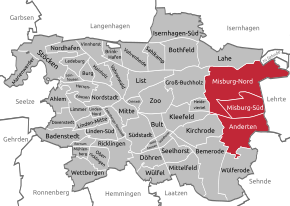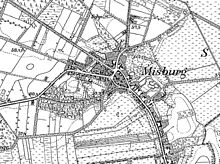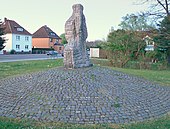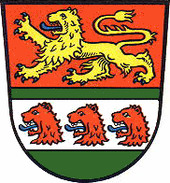Misburg-Anderten
| map | |
|---|---|

|
|
| Basic data | |
| Borough | Misburg-Anderten (5) |
| Residents | 32,529 |
| Postcodes |
|
| Districts |
|
| Web presence | hannover.de |
| politics | |
| District Mayor | Klaus Dickneite (SPD) |
| City District Council (19 seats) |
SPD : 8, CDU : 6, Greens : 3, WfH : 1, Pirates : 1 |
Misburg-Anderten is the 5th district of Hanover . It has 32,591 inhabitants and consists of the districts Misburg-Nord (22,186 Ew.), Misburg-Süd (2,763 Ew.) And Anderten (7,642 Ew.) (As of 2015).
Misburg
Misburg, first mentioned in a document in 1365, developed in the 19th century from a small village to an industrial community due to the cement industry that settled here. In 1963 Misburg was declared a city in 1974 as part of the Lower Saxony municipal reform and was incorporated into Hanover and today consists of the districts of Misburg-Nord and -Süd.
history
Emergence
The Misburg urn cemetery , discovered in 1958, points back to the time of the Great Migration.
Misburg was first mentioned as Mudzborgh in 1365 in a document in which Duke Wilhelm of Braunschweig and Lüneburg granted the citizens of Hanover the privilege of cutting peat between Altwarmbüchen , Lahe and the Misburger (Mudzborgher) wood in Altwarmbüchener Moor .
“By God's grace we Herr Wilhelm Herzoge tho Brunswick and a. 1365 to Lüneborch confess openbahr in this Breve dat we usen leven Borgern user city of Hanover raise georlovet unde Gegeven ewichliken to bridging, there like op dem More, there lecht between the Warmboke ande the Mudzborgher Holte unde the lae torff stuck and let them grave and those ... "
In a document from Bishop Gerhard von Hildesheim from 1373 it is stated that Misburg is responsible for the repair and expansion of the Hanoverian Landwehr ("the Landwere between Middesborch and Hanover ..."). The mayor of Hanover, Christian Ulrich Grupen, described Misburg in his Origines et Antiquitates Hannoverenses 1740 as follows:
- "Mißborg a wild Feldmarck including the misbearers Holz has been a Borch for times, belonging to the Hildesheim stift, now the von Alten live there."
In 1525 Misburg was a farming settlement with around 25 inhabitants, whose farms were in the area of today's Anderter Straße, between today's Waldstraße and the Kreisstraße. During this time the "Mudzborch" was abandoned and fell into disrepair. In 1585 the village had seven farms, which increased to 18 by 1800. The village life in Misburg from this time is still partly recognizable in street names. The rose festival (“Rosenfeststraße”), which was celebrated annually in summer between 1817 and 1917, its founder Ludwig Cropp (“Croppstraße”) and the forester's house demolished for the construction of the town hall (“Am Alten Forsthaus”) suggest this era.
Notation
The spelling of Misburg changed from Mudzburg via Meßborg or Mißborg via Missburg (documented in 1740) and finally to Misburg . According to a legend , Misburg was named after the castle of the knight Miss . According to other sources, the word “Mis” comes from a local dialect that has since disappeared and has been replaced by High German and simply means “moor”. This turns Misburg into a castle in the moor.
Mudzborgh
The medieval Mudzborgh Castle is said to have once stood in the area where the “Behind the Old Castle” road is today. Sand walls were still there until 1947. The actual location of the castle is presumed to be on the site of today's St. Anne's Church, as remains of the foundation wall and hewn sandstone blocks were exposed during its construction in 1955. Due to the rapidly progressing construction of the church, the area could not be further archaeologically examined.
industrialization

An enormous growth spurt through industrialization began in 1870 through the emerging cement industry . The marl discovered in the ground was burned in lime kilns and processed into cement. The railway line passing by made it easier to remove the cement. Four factories were built by 1900:
- Hannoversche Portland-Cementfabrik AG (1873–1986 / 90)
- Portland cement factory Germania (1881–1976)
- Teutonia Zementwerk (1887), since 2004 HeidelbergCement
- North German Portland cement factories (1898), (today Holcim )
In addition to the cement industry, the fuel factory in Misburg also came into being in the second half of the 19th century. As a result of these foundations, there was a strong growth in the population as well as an expansion of the village with new housing developments ("Jerusalem"), which were shaped by the immigrants from Silesia.
The Gustav Bratke era
Misburg's history in the first half of the 20th century was decisively shaped by the social democrat Gustav Bratke . The trained lithographer came to Misburg in 1910 and worked here initially as a warehouse keeper in the consumer association , soon together with his wife as its managing director. Since 1912 he was a member of the Mizburg municipal council for the SPD , an event that he later commented on with the words:
"When I was elected to the Misburg community council for the first time 40 years ago, I did not know that this election would affect my whole later life."
In 1919 he became the mayor of Misburg and in 1920 he was a member of the SPD in the provincial parliament of the Prussian province of Hanover ; 1926 also chairman of the provincial administration. Gustav Bratke's communal and social policy was characterized by a combination of industrial settlement and communal investments. He had the community buy building land so that in 1931 he succeeded in establishing the Deurag-Nerag oil refinery in Misburg. He had 154 community-owned houses and 250 apartments built in Misburg and promoted home construction. In 1925/26 the architect Friedrich Fischer built his own waterworks , the first sewer system and two sewage treatment plants, and in 1926 the youth home was also built by Friedrich Fischer. During the Great Depression he arranged for a people's kitchen to be set up in what was then the gym. At that time, around 2,000 of the 7,000 inhabitants of Misburg were unemployed. In 1933 Gustav Bratke was forced out of all political offices by the National Socialists.
Second World War
During the Second World War , Misburg was hit by around 40,000 high explosive and incendiary bombs in around 45 Allied air raids on Hanover, and 60% of the residential buildings were destroyed or damaged. The attacks were aimed at companies important to the war effort, such as the Deurag-Nerag refinery and the Misburgs cement factories . However, just under 4% of the bombs hit the refinery as the target of the Allied air offensive against the German mineral oil industry.
In 1944 the Ahlten substation set up a test facility for high-voltage direct current transmission to Misburg.
The writer and World War II veteran Ernst Jünger , who lived in nearby Kirchhorst from September 1944 , noted in his diary entries "Kirchhorster Blätter" about the air raids on Misburg:
"16. September 1944. Numerous overflights. Misburg, the main target in the vicinity, was hit again, and large oil reserves burned down on the other side of the moor under lead-gray clouds of smoke ... "
On March 15, 1945, the day of the heaviest air raid on Misburg, he noted:
“In the evening, during these entries, one of the heaviest attacks on Misburg. Scout planes first sowed a veritable avenue of orange-yellow illuminated signs, then the drops followed. "

From June 1944 to April 1945, the subcamp Hanover-Misburg of the Neuengamme concentration camp was located near the premises of the refinery . The first prisoners were Belgian and French resistance fighters. They were used for clean-up work on the Deurag-Nerag refinery site damaged by bombing . An average of 1,000 prisoners were housed in the camp; around 55 are said to have died during its existence. Towards the end of the war, the prisoners were led on a death march north towards Neuengamme, which ended on April 8, 1945 in the Bergen-Belsen concentration camp . In 1989, a sculpture by Eugène Dodeigne was erected as a memorial on the former camp site on Hannoversche Strasse at the level of the Mittelland Canal .
Further development
After the Second World War, Misburg devoted himself to the “European idea” and established several town twinning arrangements: Bollnäs (Sweden, 1961), Flekkefjord (Norway, 1970), Shepton Mallet in Somerset (Great Britain, 1961) and Morsö (Denmark, 1970). In 1972 Misburg received the flag of honor from the Council of Europe as thanks for efforts to promote international understanding .
During the municipal reform of Lower Saxony , the city, which Misburg has been since July 29, 1963, was incorporated into Hanover on March 1, 1974. In the course of the introduction of city districts in 1981, the two Misburg districts Misburg-Nord and Misburg-Süd were merged together with the Anderten district as the Misburg-Anderten district. The town twinning will be continued by the city district.
At the end of the twentieth century, some cement works and the DEURAG-NERAG oil refinery were shut down.
Misburg-Nord
The district is bounded in the northeast by the Misburger Wald and the A 2 motorway , in the east by the city limits that run parallel to the A 7 motorway , in the south by the branch canal to Misburger Hafen and in the northwest by the streets Gundelrebe and Bollnäser Straße and further south-west of the Mittelland Canal parallel to Kauzenwinkelhag, the streets Milanstraße, Am Stadtrand, west of the Grenzstraße and from there in a southerly direction to the railway line.
After Misburg had had an independent Evangelical Lutheran parish since 1894 , the St. John's Church designed by Karl Mohrmann was built in the years 1902–1904 . Other churches in Misburg-Nord are the Evangelical Lutheran Trinity Church from 1963 with its free-standing tower, the Catholic St. Anna Church from 1956, the Ukrainian Ecumenical Center St. Volodymyr from 1984 and a New Apostolic Church. The Misburg forest cemetery (also: Misburg district cemetery ) was opened in 1921 on Waldstrasse on the edge of the Misburg Forest . The 7.9 hectare cemetery has space for 4,500 graves and is managed from the Lahe city cemetery .
The Misburg community center has existed since 1971 .
In December 2010, Misburg-Nord was connected to the Stadtbahn by extending line 7 from Paracelsusweg, formerly Lahe, to the provisional terminus on Schierholzstraße. The further extension of the route to Meyers Garten with the stations Kafkastraße and Am Forstkamp and the new end point Misburg at the Misburg town hall went into operation in December 2014. The bus routes 124, 125 and 127 take over the further development of the district .
There are three primary schools in the district (Mühlenweg, Pestalozzischule I, Kardinal-Galen-Schule), the Misburg secondary school and the Misburg Kurt-Schwitters-Gymnasium.
Misburg-South
The district is bounded by the Mittelland Canal, the branch canal to the Misburg harbor, the railway line to Lehrte and the city limits in the east. It is shaped by the cement industry located here. On the border with Anderten is the Hannover-Anderten-Misburg S-Bahn station , where the S3 (Hannover – Hildesheim) and S7 (Hannover – Celle) lines of the Hannover S-Bahn stop. Otherwise, bus line 125 opens up the district and connects it with Misburg-Nord and Anderten.
The Sacred Heart Church , built in 1904/05 as a parish church for the Catholics who moved here in the course of industrialization, was converted into a columbarium in 2010 .
The Kleines Nordfeld residential area, which used to belong to Anderten , was added in 1979 as part of a border straightening in Misburg-Süd. Efforts by local residents to reverse this change have been unsuccessful.
Sports
Personalities
- Friedrich Wilhelm Barkhausen (1831–1903), born in Misburg, lawyer, church politician, member of the Prussian manor house, curator of the Loccum monastery
- Hermann Manske (1839–1919), factory owner, 1886 founder of the cement factory "Germania"
- Heinrich Friedrich Ludwig Meyer (1839–1928), chess composer
- Max Kuhlemann (1857–1929), factory owner, councilor, owner of the Portland cement factory founded by his father Friedrich Kuhlemann
- Gustav Bratke (1878–1952), 1919–1933 municipal director of Misburg, first Lord Mayor of Hanover appointed by the British military government in 1946 , organized the first Hanover Fair in 1947, and in 1952 an honorary citizen of Misburg
- Christian Kuhlemann (1891–1964), engineer, since 1925 director of the Portland cement factory founded by his grandfather Friedrich Kuhlemann in Misburg, member of the Bundestag (NLP / DP 1949–1953), President of the Hanover Chamber of Commerce and Industry (1953–1964)
- Herta Dürrbeck (1914–1995), communist resistance fighter
- Axel Plaue (* 1950 in Misburg), SPD politician, 1986-2008 member of the Lower Saxony state parliament, chairman of the Hanover district association of the AWO
- Lena Meyer-Landrut (* 1991), singer and winner of the Eurovision Song Contest 2010
Changed


The Anderten district is essentially bounded by the Tiergarten in the west, the railway line to Lehrte in the north, the Mittelland Canal in the east and the Südschnellweg in the south.
history
Anderten was first mentioned in a document in 985. King Otto III. set a border between Ostfalen and Engern - and thus between the dioceses of Hildesheim and Minden . A certain "Bernhard Bidonis filius de Ondertunun" witnessed this area regulation. At that time the name Ondertunun referred to a settlement protected by a fence. Anderten is the only district in Hanover to be located in the historic settlement area of the Great Free . This settlement area, which emerged in the 12th century, included 13 other villages in the area of today's cities of Sehnde and Lehrte . Around 1600 Anderten consisted of around 60 farms. In 1641 and 1661, Anderten was hit by large fires that destroyed almost half the village.
In 1843 the age of the railroad in the Kingdom of Hanover began with a train journey from Hanover via Misburg to Lehrte . The Anderten-Misburg station was not built until 1906, when the new Tiergarten – Lehrte line was opened to relieve the Misburg station, which was then closed to passenger traffic. In 1897 the tram reached Anderten on the way to Sehnde , from 1901 there was a branch line through the town to Misburg. The latter was discontinued in 1951, and the line to Sehnde was closed in 1960.
In 1919, the construction of Europe's largest inland lock began on the Mittelland Canal . On June 20, 1928, the Anderten lock was opened by the then Reich President von Hindenburg . At the same time, traffic on the Mittelland Canal to Peine and Hildesheim was released after operations from the Dortmund-Ems Canal to Misburg had already started in 1916 .
In 1969 Anderten and the French municipality of Oissel in Normandy founded a partnership that is continued today by the municipality. The old Anderter Gartenstrasse was renamed Oisseler Strasse; In return, there is an “Avenue d'Anderten” in Oissel. There are regular youth exchanges and connections between TSV Anderten , Sportfreunde Anderten and the Misburg sports community.
With the municipal reform, the previously independent village was incorporated into Hanover on March 1, 1974. In 1985, the 1000th anniversary of Andertens took place with a street festival in the old village center and a large historical parade.
Townscape
In the district there is a primary school (Kurt Schumacher School), a high school (Pestalozzischule II) and an indoor swimming pool. In the Anderten lock , up to 22,000 inland vessels are guided through the 225-meter-long lock chambers every year. There is an industrial area east of the Mittelland Canal. In the south, the Stadtbahn opens up the district, in the north is the Hanover-Anderten-Misburg S-Bahn station . In December 2002, tram line 5 was extended and has been running since then via the Königsberger Ring stop to the Anderten terminus . There is a connection to bus line 125 via Misburg and Groß-Buchholz to Sahlkamp as well as to bus line 800 (Altenbekener Damm - Kirchrode - Anderten - Sehnde - Mehrum) which is also the 373 but only runs on school days at peak times.
Personalities
- Ernst Härke (1846–1914), born in Anderter, has owned the Härke private brewery in Peine since 1890
- Gisela Konrath (* 1947), CDU politician and former member of the Lower Saxony state parliament
- Bernd Strauch (1949–2015), SPD politician, 1st Mayor and Council Chairman of the City of Hanover, Chairman of the Hanover Jazz Club
- Friedbert Pflüger (* 1955 in Anderten), CDU politician and former member of the German Bundestag
District Council
In the local elections on September 11, 2011 , the SPD was again the strongest party in the district with 40.1% of the votes, and Klaus Dickneite is the district mayor. The Greens were 14.8%, the third strongest party after the CDU (31.6%) and using Uta Engelhardt, the Deputy Mayoress. The District Council Misburg-Anderten meets about seven times a year in public in the Misburg town hall and twice a year in public in the Kurt Schumacher School in Anderten.
See also
literature
- Helmut Zimmermann : From Anderten to Stöcken. Forays into Hanover's history . Hanover: Harenberg-Labs 1987, ISBN 3-89042-023-0
- 75 years of the Hindenburg lock 1928–2003. Information about the development and importance of inland shipping, the Mittelland Canal and the Hindenburg lock in Hanover-Anderten . Compiled by Lorenz Kurz. Hanover: Waterways and Shipping Directorate 2003.
- Anton Scholand : Misburg's soil and population through the ages (chronicle). 1st edition Hildesheim and Leipzig: Verlag August Lax 1937 2nd edition Hildesheim: Verlag August Lax 1960; 3rd revised edition, supplemented by Valentin Bialecki, Hannover-Misburg: Verlag Werbestudio Illmer 1990
- Lorenz Kurz: Changes in words and pictures , reports and illustrations from the past and present, 1985 - 184 pages. Self-published by Lorenz Kurz
- Anton Scholand: Anderten and the free before the north forest (chronicle). Hildesheim 1970
- Christian Ulrich Grupen : Origines et Antiquitates Hanoverenses or Complicated Treatise on the Origin and Antiquities of the City of Hanover, which includes documents, seals and coppers The state of the city and the counties and rulers lying around, as well as monasteries, the same of many noble families to the Light is put and the German rights are explained. Göttingen, published by the privileged university bookstore, 1740.
- Wolfgang Jakob: Misburg and Anderten then from AZ , ed. from the Arbeitsgemeinschaft Misburger and Anderter Kulturvereine (AMK) EV 1981
- Wolfgang Illmer : Chronicle Misburg, origin to present , first edition 2012, wochenspiegel-verlag GmbH Hanover, ISBN 978-3-00-038582-7
Web links
- City district portal Misburg-Anderten
- Structural data of the city districts and districts of Hanover as of 2020, a publication of the city of Hanover
Individual evidence
- ↑ Dietrich Oeding , Bernd R. Oswald : Electrical power plants and networks. Verlag Springer, Berlin 2004, ISBN 3-540-00863-2 , p. 838 ( excerpt in the Google book search).
- ↑ Council of Europe: List of the European Prize Winners ( Memento of the original from May 28, 2011 in the Internet Archive ) Info: The archive link was inserted automatically and has not yet been checked. Please check the original and archive link according to the instructions and then remove this notice. (PDF; 141 kB)
- ↑ a b Federal Statistical Office (ed.): Historical municipality register for the Federal Republic of Germany. Name, border and key number changes in municipalities, counties and administrative districts from May 27, 1970 to December 31, 1982 . W. Kohlhammer GmbH, Stuttgart and Mainz 1983, ISBN 3-17-003263-1 , p. 189 .
- ↑ Marcel Schwarzenberger: The home question divides a district in Hannoversche Allgemeine from April 27, 2010
- ↑ Lena: "I enjoy my time here very much." In Neue Presse (from May 27, 2010, accessed on June 10, 2010)
- ^ HAZ District Gazette South of May 2, 2013
Coordinates: 52 ° 23 ' N , 9 ° 52' E








